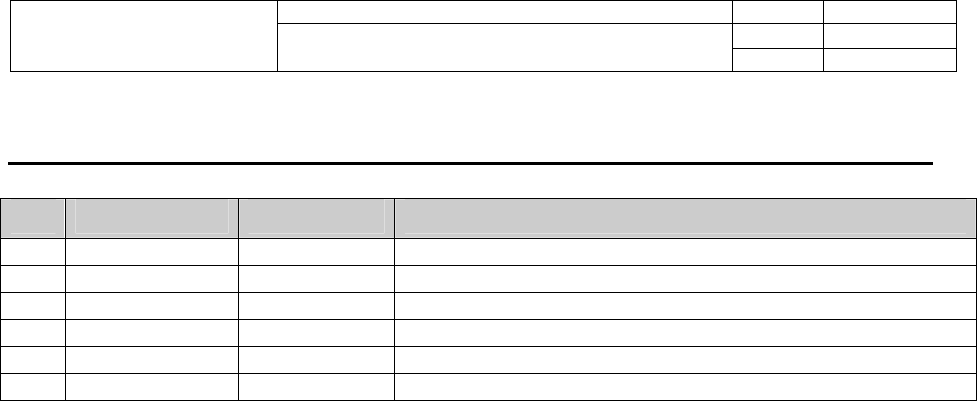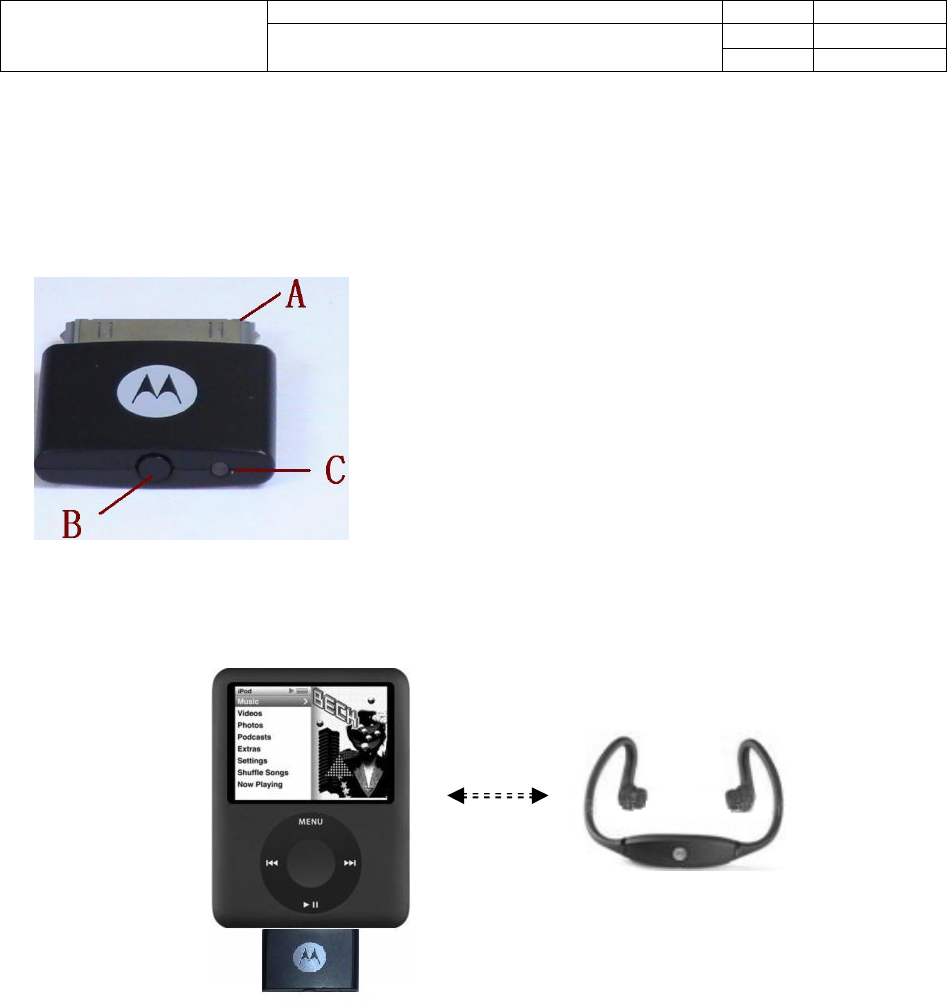Motorola Mobility T6KZ1 IPOD BLUETOOTH ADAPTER User Manual D670 EN 0422
Motorola Mobility LLC IPOD BLUETOOTH ADAPTER D670 EN 0422
Users Manual

Content Rev V0.1
Date 2009/03/19
D670 User Manual Page 1/5
D670 User Manual

Content Rev V0.1
Date 2009/03/19
D670 User Manual Page 2/5
Revision History
Rev.
Date Author Reason for Changes
0.1 2009/03/19 Wayne Zhang Initial Draft

Content Rev V0.1
Date 2009/03/19
D670 User Manual Page 3/5
1. Product Introduction
The D670 iPod Bluetooth adapter is used for enjoying stereo music wirelessly from iPod
with the stereo Bluetooth headset.
2. Product Exterior
A: iPod Connector
B:Button
C:LED indicator
3. How to use
1) Pair with the Bluetooth headset
Mode 1:Plug D670 into the iPod connector. When the indicator C enters express
alternately flashing red and blue state, it means the D670 has entered pairing
state. Please put the Bluetooth headset into pairing mode. After the LED
turns blue and starts to blink every 7-8Sec., it means D670 has paired with
Bluetooth headset successfully. And you could enjoy stereo music from iPod.
Mode 2:Plug D670 which has been pre-paired into the iPod connector. The LED starts
blinking blue and enter connectable mode (flash twice every 1Sec.). At this
time, the D670 will try to find the headset pre-paired. Meanwhile, please power
on the pre-paired headset. When the LED turns blue and begins to blink every
7-8Sec., it means the connection has been established. If the D670 does not
find the pre-paired headset in 40Sec, the D670 will enter Mode 1.

Content Rev V0.1
Date 2009/03/19
D670 User Manual Page 4/5
If the D670 does not find any Bluetooth headset in 5Min., it will power off and
the LED indicator will be off.
2)Enter Pairing Mode
Mode1: When the D670 is off, please single press button B to push it into
connectable mode with the blue LED blinking fast. Meanwhile, the D670 is
trying to find the pre-paired headset.
Mode 2:When the LED blinks blue fast, please press the button B for 2Sec. and then
release, the D670 will enter pairing mode with the red and blue LED flash
alternately.
3)Clear pre-paired headset info.
Please press button B and then plug the D670 into the iPod connector and release.
It will clear the pre-paired headset information and enter pairing mode with the red
and blue LED flash alternately.
4)Power on/off the D670
Please hold pressing the button B for at least 10Sec., the D670 will be power off
with the LED off.
Single press the button B, and the D670 power on with the red and blue LED flash
alternately to enter pairing mode or the blue LED blinking fast to find the pre-paired
headset.

Content Rev V0.1
Date 2009/03/19
D670 User Manual Page 5/5
Industry Canada Notice to Users
I Operation is subject to the following two conditions: (1) This device may not cause
interference and (2) This device must accept any interference, including interference
that may cause undesired operation of the device. See RSS-GEN 7.1.5.
FCC Notice to Users
Motorola has not approved any changes or modifications to this device by the user.
Any changes or modifications could void the user’s authority to operate the
equipment. See 47 CFR Sec. 15.21.
This device complies with part 15 of the FCC Rules. Operation is subject to the
following two conditions: (1) This device may not cause harmful interference, and (2)
this device must accept any interference received, including interference that may
cause undesired operation. See 47 CFR Sec. 15.19(3).
This equipment has been tested and found to comply with the limits for a Class B
digital device, pursuant to part 15 of the FCC Rules. These limits are designed to
provide reasonable protection against harmful interference in a residential
installation. This equipment generates, uses and can radiate radio frequency energy
and, if not installed and used in accordance with the instructions, may cause
harmful interference to radio communications. However, there is no guarantee that
interference will not occur in a particular installation. If this equipment does cause
harmful interference to radio or television reception, which can be determined by
turning the equipment off and on, the user is encouraged to try to correct the
interference by one or more of the following measures:
• Reorient or relocate the receiving antenna.
• Increase the separation between the equipment and the receiver.
• Connect the equipment to an outlet on a circuit different from that to which the
receiver is connected.
• Consult the dealer or an experienced radio/TV technician for help.